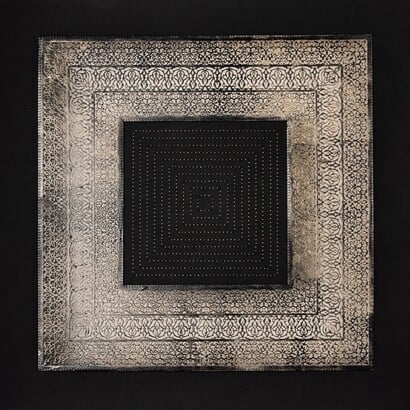“What if I made it so beautiful it can make you cry?” Intricate sculptures at the Amon Carter
ArtandSeek.net October 7, 2021 28Editor’s Note: “A Beautiful Despair” at the Amon Carter Museum features metal works by Pakistani artist Anila Quayyum Agha. The exhibition closes on January 9, so we thought we would revisit this story by Jerome Weeks.
“It’s so delicate,” said Anila Quayyam Agha. “Yet it weighs about 450 pounds.”
Agha was speaking of a large, intricately cut, lacquered metal cube suspended in mid-air at the Amon Carter Museum in Fort Worth. It’s a daunting presence like a giant, steel spider’s web — looming but also porous and glowing (with two light bulbs transforming the entire gallery space into so many lacy shadows). The Amon Carter commissioned the work, titled “A Beautiful Despair” — which is also the name of the 15-artwork exhibition. Agha spoke at a press preview in September.
Agha earned her master’s degree in art at UNT, having come from her native Pakistan. In 2016, she became the first artist, ever, to receive both the juried and the public award at the Art Prize in Michigan – winning $300,000 total.

Anila Quayyum Agha, “A Beautiful Despair,” 2021 laser cut lacquered steel turquoise.
Agha’s earlier works — some of which are included in “A Beautiful Despair” — use drawings or paper cut-outs of traditional Islamic geometric patterns to which she’s embroidered bright, metallic threads (she studied textile design at the National College of Arts in Pakistan). In these works, she’s tying together — literally — the religious and the domestic, the traditional and the modern, Middle East and West.
“It’s sewing elevated from a craft or handiwork,” said Amon Carter curator Shirley Reece-Hughes.
But it’s Agha’s large-scale, sculptural installations that have brought her international acclaim: They’re like giant, illuminated manuscripts turned into machined steel. Agha said she does not see the use of shadows in these works as a form of ‘darkness’ dividing the light but as another color forming shapes and patterns.
But she also noted the contrasting funeral attire in the two cultures: In the West, mourners traditionally wear black. In Muslim countries, they wear white. So “A Beautiful Despair” weaves the two together. Even her title, “A Beautiful Despair,” is meant to bring together what are typically viewed as opposites.
“That’s the life I live now,” she said. “Living on the border of both cultures, looking in.”

“Captive Shadow 1,” 2020, mixed media on paper
Noting the way the cube’s patterns contain shapes within shapes, crosses inside of squares inside of circles inside of diamonds, she said, “Light can look so simple and yet it’s so complicated. The more you look, the more you see.”
As visually stunning as these artworks are, they are also rigorous feats of geometry and engineering — to situate the right-sized cube the precise distance from the light source and from the walls surrounding it ensuring the different facets will cast just these kinds of clear-cut, overlapping shadows that line up where the walls meet the ceiling. Agha credited her partner, Steve Parchyl, with doing the necessary math.
Ultimately, though, Agha said she is in pursuit of the beautiful. In graduate school, she said, the beautiful in visual art was seen as obvious, overused, sentimental. But to her, the beautiful can still be a tremendous power an artist can wield.
“What if I made it so beautiful,” she asked, “it can make you cry?”
Got a tip? Email Jerome Weeks at jweeks@kera.org. You can follow him on Twitter @dazeandweex. Art&Seek is made possible through the generosity of our members. If you find this reporting valuable, consider making a tax-deductible gift today. Thank you.









